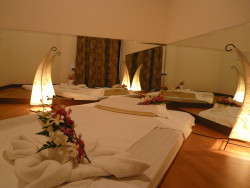
May 1, 2003
Pilgrim’s Progress
Simon Rowe braves the storms and heads down to Shikoku’s “Typhoon Ginza,” Cape Ashizuri.
By Metropolis
Originally published on metropolis.co.jp on May 2003

Photos by Simon Rowe
Key Largo, the classic thriller starring Humphrey Bogart, may not be well-known on the mountainous Japanese island of Shikoku, but at Cape Ashizuri, its most westerly and weather-beaten tip, similar scenarios are played out each summer during the typhoon season.
In the movie, Bogart plays a leather-chewing WWII veteran who visits the hotel of his dead friend’s family only to find himself held hostage by mafia hit men, while outside a tropical storm rages and keeps them all confined in a heightening tension that dramatically breaks with the weather.
Cape Ashizuri sets a similar scene, though it’s more likely to be the balmy sub-tropical climate, an occasional typhoon, or the quirky local characters that keep one confined for days on end. Accommodation is surprisingly plentiful; strung out along the rocky headland, minshuku, or family-run guesthouses, all seem to have at least one room with an ocean view at a back-road traveler’s price.
Minshuku Hassen, or Eight Fans Guesthouse, was my choice for ¥3,500. The name sounds like the word for “eight thousand,” and I was in no doubt which one best fitted the guesthouse’s location—the view from my room’s window seemed to span that much in kilometers across the Pacific Ocean.
Taken by storm
From June through September, Shikoku takes the brunt of the typhoon season, so much so that the Cape’s inhabitants jokingly refer to their stretch of coastline as the “Typhoon Ginza” of Japan and have incorporated bunker specifications into their houses—steel window shutters and reinforced walls clamped down by heavy clay roof tiles—to ensure the village doesn’t flutter off to Siberia each year.
All except the owners of Minshuku Hassen, it seemed. It was a wonder the chalky prefab walls had not already taken flight during the last season of some 18 typhoons. The fly screen in my room had certainly blown itself clean, hairline cracks ran floor to ceiling, and a large glob of gecko pooh had followed one fissure down before coming to a standstill just above the coin-operated TV.

Key Largo was made in 1947, which was about the same time my room appliances appeared to have been installed. Save for an empty green sake bottle plugged with a plastic rose, my bathroom was a totally duck-egg blue experience; the futon had as much bounce as a rice cracker, and my traditional wheat chaff-filled pillow gave me bad dreams about drowning in grain silo.
The only other guest I saw was a sunburned surfer who had checked into the room labeled “hana,” or “flower,” next to mine. He never said a word as we passed each other in the hallway every morning, but then I doubt if he could judging by the way the sunburn had stretched his face into a permanent grin.
The manager of the guesthouse was a tough elderly woman who swaggered around barefoot with a squint that reminded me of an estuary clam. She requested that I call her oba-chan, or “auntie,” and after offering me a welcome drink of roasted green tea and a plate of sandy-tasting biscuits, proceeded to give me the rundown on the Cape Ashizuri’s temples, which she thought I might be interested in.
Actually, I was keener to locate the statue of Nakahama Manjiro, otherwise known as “John Man,” the first Japanese to set foot on a foreign shore after Japan closed its door to foreigners in 1639. Local lore has it that, in 1841, Nakahama set out on a fishing expedition from the nearby fishing village and was shipwrecked in a storm. He was picked up by an American whaling boat, given the name “John Man,” and taken back to the US, where he studied English, became a ship’s captain and worked in a gold mine, before returning to Japan years later to help facilitate the country’s reopening to the world.
With auntie’s directions and a gritty residue in my mouth, I found myself on a path winding down through neighborhoods steeped in aromas of seaside Shikoku: simmering fish, bonito sauce and freshly-shucked oysters.
Hugging the headlands, the trail snaked on through thick groves of fan palms, intermingled with bamboo forest and mossy ledges beneath which up to 80 meters of fresh sea air separates the hiker from powerful ocean swells below.
Over the edge
Cape Ashizuri’s sea bluffs have an unfortunate reputation for being one of the country’s most popular suicide spots, and I occasionally glimpsed signs posted along the headlands asking potential jumpers to consider their family and friends before leaping. I couldn’t help but see the black humor of a hotel receptionist’s gesture when she handed me a small packet bearing the hotel’s name on the back. Inside were a dozen band-aids.

The Goddess of Mercy can be found waiting for those who visit Kongofuku-ji temple, the 38th of Shikoku’s 88 “holy places,” and a structure that has been weathering the Cape’s winds and tides of pilgrims since the mid-1600s. It’s not uncommon to hear of businessmen, housewives and university students from around Japan who literally drop everything to become henro, or pilgrims, in order to cleanse their souls of the “88 human vices” by visiting each of the island’s Shingon Buddhist temples—a journey which is often made on foot and can take up to two months to complete.
I was almost swept up by a dozen henro, swathed in their trademark white cotton vests and carrying walking staffs and conical straw hats, as they poured out through Kongofuku-ji’s stone torii archway with such speed and excitement I could only guess they were heading for a divine feast of local oysters and cold Kirin lager at the village restaurant.
A short distance away and commanding the most idyllic ocean view on the entire Cape, stands the statue of “John Man.” From beneath his imposing figure, which is mounted on a typhoon-proof block of granite, you can watch as local fisherman take out boat-loads of tourists and deposit them on a rock of their choice with the hope of netting a “big one” each morning.
On days of mild offshore breezes, conditions are perfect. But I couldn’t help wondering what would happen if the weather took an unexpected turn and the tourists were left to fend for themselves on these tiny ocean outcrops. Perhaps “John Man,” having no doubt seen it all before, knew the answer to that one.
Getting there
Flying into Kochi from Tokyo Haneda Airport takes about 1hr 20min, with a 40-minute bus ride from Kochi Airport to Kochi stn.
By shinkansen from Tokyo, the trip to Okayama stn takes about on 3hr 20min, then another 2hr 30min to Kochi by a limited express on the JR Seto-ohashi and Dosan Line.
Once in Kochi, take the Tosa Kuroshio-Tetsudo Railway Line for the 1hr 45-min ride to Nakamura Station, then pick up the bus (departing from in front of the station) to Ashizuri Point, another 2hr ride.
Alternatively, rental cars are available at Mazda Rent-a-car (tel: 088-872-4591) and Nissan Rent-a-car (tel: 088-883-4485), located near Kochi stn.
Places to stay
Minshuku Ashizuri-misaki Hassen (tel: 0880-88-0941) is located 200m east of Ashizuri-misaki village post office, also the terminus for buses arriving from Nakamura. Look for the thin white building overlooking the sea on your left. Rates are ¥6,800pp/pn and include two meals.
Ashizuri Kokuminshukusha (tel: 0880-88-0301) also has rooms for ¥6,600pp/pn and is located near John Manjiro’s statue and the tourist information office.
For more listings and reservation assistance, talk to the friendly, English-speaking tourist office staff at Information Tourist Center (tel: 0888-82-7777), located outside Kochi train station; open 9am-5pm daily.
[geo_mashup_map]







